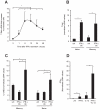Interferon-alpha triggers B cell effector 1 (Be1) commitment
- PMID: 21559410
- PMCID: PMC3084831
- DOI: 10.1371/journal.pone.0019366
Interferon-alpha triggers B cell effector 1 (Be1) commitment
Abstract
B-cells can contribute to the pathogenesis of autoimmune diseases not only through auto-antibody secretion but also via cytokine production. Therapeutic depletion of B-cells influences the functions and maintenance of various T-cell subsets. The mechanisms governing the functional heterogeneity of B-cell subsets as cytokine-producing cells are poorly understood. B-cells can differentiate into two functionally polarized effectors, one (B-effector-1-cells) producing a Th-1-like cytokine pattern and the other (Be2) producing a Th-2-like pattern. IL-12 and IFN-γ play a key role in Be1 polarization, but the initial trigger of Be1 commitment is unclear. Type-I-interferons are produced early in the immune response and prime several processes involved in innate and adaptive responses. Here, we report that IFN-α triggers a signaling cascade in resting human naive B-cells, involving STAT4 and T-bet, two key IFN-γ gene imprinting factors. IFN-α primed naive B-cells for IFN-γ production and increased IFN-γ gene responsiveness to IL-12. IFN-γ continues this polarization by re-inducing T-bet and up-regulating IL-12Rβ2 expression. IFN-α and IFN-γ therefore pave the way for the action of IL-12. These results point to a coordinated action of IFN-α, IFN-γ and IL-12 in Be1 polarization of naive B-cells, and may provide new insights into the mechanisms by which type-I-interferons favor autoimmunity.
Conflict of interest statement
Figures



References
-
- Pistoia V. Production of cytokines by human B cells in health and disease. Immunol Today. 1997;18:343–350. - PubMed
-
- Bouaziz JD, Yanaba K, Tedder TF. Regulatory B cells as inhibitors of immune responses and inflammation. Immunol Rev. 2008;224:201–214. - PubMed
-
- Mizoguchi A, Bhan AK. A case for regulatory B cells. J Immunol. 2006;176:705–710. - PubMed
MeSH terms
Substances
LinkOut - more resources
Full Text Sources
Miscellaneous

